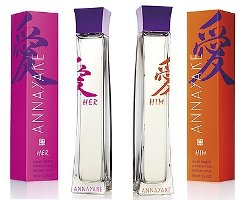
Annayake will launch Love for Her and Love for Him, new limited edition fragrances, in April. The bottles are decorated with the Japanese Chinese symbol for intense love.
Annayake Love Her ~ a green fruity floral with violet leaves, blackcurrant, lily of the valley, magnolia, lotus, jasmine, white musk and cedar.
Annayake Love Him ~ a woody fragrance with bergamot, grapefruit, bitter orange, watermelon, nutmeg, cardamom, marine accord, cedar, amber and patchouli.
Annayake Love for Her and for Him will be available in 100 ml Eau de Toilette.
(via cosmoty.de)
Ahh, more of that white musk!
Both seem aquatic and meh..watermelon?
Watermelon+white musk..a love that was written in the stars!
It is everywhere. It’s not always overdone though!!
Chinese symbol, not Japanese and it just means “love” not “intense love” lol I’m just being picky for the sake of it. Watermelon, eh? Interesting.
Ack. Simple google image search confirms you are correct, my apologies!
Oh, how funny, Robin. I was just nitpicking out of sheer borefom 🙂 I’m taking inventory right now and it is the least favourite part of my job.
Oh, I prefer nitpicking — best to be factually correct if nothing else! I wonder what the original press materials say — do not think Cosmoty would have written that if it wasn’t in the original press materials?
And my sympathies for the inventory!
Well, I read and write both Mandarin Chinese and Japanese, and the character is acceptable in both languages as love:
Chinese: http://goodcharacters.com/chinese.symbol.for.love.html
Japanese: http://waktattoos.com/id38594/for-different-ways-to-write-the-japanese-kanji-character-love-400×400-pixel.html
Now to nitpick it’s true that Japanese classifies the character as a part of the kanji system, words originated from Mandarin. In mainland China the character has been simplified, but I learned the traditional Mandarin system. In Japanese the verb conjugations are a bit more complicated than the Mandarin, but then the character itself works just fine.
Now technically Chinese (the language) denotes Cantonese, technically a dialect from China spoken mainly in Guangzhou and Hong Kong, and I have seen the same character being accepted at least in Hong Kong as well.
Thank you so much for the clarification.